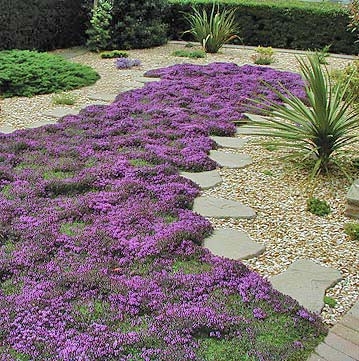

Thanks for really useful info on thyme plants. This one doesn’t do quite as well in climates that are hot year-round. It is cherished for its leaves, but does produce some pink to purple flowers in summer. Like most thyme varieties, it is rather drought-tolerant.
#CREEPING RED THYME GROUND COVER FULL#
It spreads up to 18 inches, grows best in full sun, and attracts plenty of butterflies and bees. Mediterranean Creeping Thyme: This plant produces lots of deep pink flowers in big clusters.


It spreads quickly and can reach 24 inches in diameter. Pink Chintz: A variety of the genus thymus serpyllum, pink chintz thyme is characterized by its fuzzy, dark green foliage with light to dark pink flowers.Individual plants will spread to 18 inches. It creates a purple carpet that can be walked over, hence its name. It is very low-growing and covered in beautiful lavender flowers during early to mid-summer. Purple Carpet: This is probably the most used.Below are some of the most popular types. There are several varieties of creeping thyme that come in different colors and characteristics. Photo via Flickr by Riley Creeping Thyme Colors and Types Varieties like this wooly thyme tolerate foot traffic quite well.

To harden off the cutting, place it outdoors for increasing lengths of time each day for several weeks.If it resists, it has rooted and is ready to be hardened off and transplanted outdoors. After a few weeks, you can test the cutting by pulling on it gently.You may cover it with plastic to retain moisture and then place in a sunny area. Place the cut end of the stem in rooting hormone powder, and then insert it immediately into the growing medium.Poke a small hole into the medium using a Q-tip or pencil.Have a planting tray ready with a growing medium such as seed starting mix or coarse sand.Remove the leaves from the bottom third of the stem.Take a cutting from a stem during the late spring or early summer when the plant is thriving.Propagation is growing a new plant from a cutting. Small chunks of it can be dug up and transplanted elsewhere, and those will usually continue expanding in their new home. Thyme is a carpeter, so it sends down more stems into the ground as it expands. Most creeping thyme plants are easily reproduced via division or propagation. Creeping thyme grows in USDA hardiness zones 2 through 9, although some varieties do better in warmer climates.(This gives the other plants in your garden the benefit of those extra bee visitors who will facilitate more pollination.) Bees are attracted to it-you’ll see bees buzzing about it during summer mornings.It's ideal for gardeners who are worried about pests, pets, or kids traipsing through their yard and holds up very well if walked on.Although it is not often harvested, creeping thyme, like any thyme variety, is edible and can be made into teas or other herbal remedies.It has tiny, hair-covered oval leaves with similarly-sized flowers that grow in clumps.It does not grow very tall-only about two to four inches maximum, so it won’t steal the show from other plants or shrubs.It's perennial, returning every year and requiring much less maintenance than grass.It covers the ground in color and breaks up all of the green.During its peak blooms, it appears to have more flowers than foliage.


 0 kommentar(er)
0 kommentar(er)
